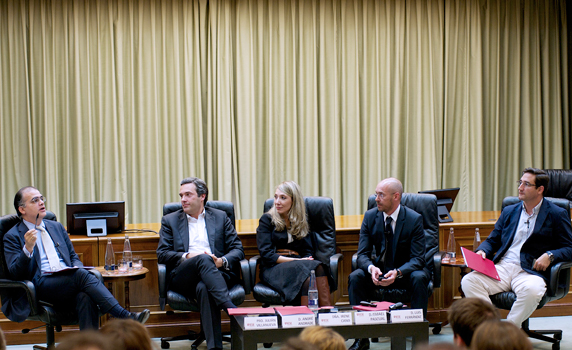
What new challenges do online media present for brands? How has planning changed since the disruption of digital media? What are the new trends in the world of communication? What are the forces shaping new media strategies? These were among the questions addressed during the Continuous Education session “New Media Strategies,” held May 21 on IESE’s Madrid campus.
Organized by IESE’s Alumni Association, the event was moderated by IESE Prof. Julián Villanueva and Luis Ferrándiz, partner in the agency DNA. “The digital world has brought with it many new channels that are not always easy to integrate with traditional ones,” said Villanueva.
André Andrade, CEO of Aegis Media Iberia, said that two trends have revolutionized the communication world in recent years: globalization and convergence. In his opinion, globalization has forced brands to adjust their positioning in every country where they are present.
At the same time, technological change has turned consumers into powerful actors who avidly share data and information with each other in real time through the distinct digital platforms they have at their disposal. “All this is interconnected, interdependent and transparent,” he said.
Everything has changed
Andrade said that in recent years the providers of global infrastructure have changed. Companies such as Apple, Amazon, Facebook and Microsoft have acquired greater importance in the new media panorama. “The point of commitment to the brand and the point of sales transaction have moved closer. This means that companies have to change their media strategies in a radical way,” he said.
In this new communications ecosystem, consumers play a central role and all marketing planning centers on them. “Everything has changed. Today, due to a relatively low investment in production and distribution, digital content can reach many more people,” he said.
Irene Cano, country manager of Facebook, described three key features of new media strategies: convergence, measurement and social DNA. “Media and digital support have gained ground. Today, you cannot plan a campaign with tight platforms. You have to take everything into account because everything is interrelated. You should follow an integrated strategy,” she said.
“It is becoming increasingly difficult to capture the attention of the consumer. There have been changes in consumer habits and this is something to keep in mind,” she said. At the same time, she admitted that in online publicity strategies, the correlation between clicks and sales remains unclear, so more reliable measurement systems need to be developed.
Efficient segmentation is one of the key advantages that online media can bring to media strategy, she said. “To be social is not just a goal. It is a means for achieving objectives,” she said. She also outlined four components that form part of social marketing: connecting, interacting, influencing and integrating. “We recommend generating online content through users, because they are the great generators of ideas,” she said.
Obsession with sales
Cano also stressed continued investment in new platforms and cautioned against the “obsession” that many companies have about selling via the internet. “It doesn´t make sense. The important thing is to sell and that the brand uses all the opportunities offered by available platforms,” she said.
Ismael Pascual, head of integrated communication at Coca-Cola, said that many companies have a presence on social media but don’t know really know what to do with it. “Creativity, finding new spaces and knowing how to adapt content to digital media are essential in order for brands to be successful with online content,” he said.
He also said that, in spite of efforts made by many companies to generate their own online content, there are major gaps in ROI measurement systems. Yet it remains necessary, he said, to invest a portion of communication budgets to experimentation and testing digital sales. In new media strategies, offer and demand should create relationships that bring added value.
In spite of advances made by organizations in their digital strategies, Andrade concluded with this message: “The financial health of many internet companies remains very complicated.”